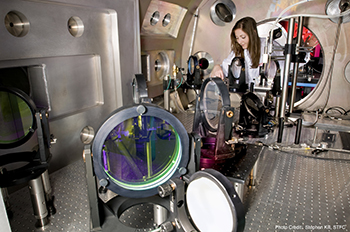
Lead author Jena Meinecke, D.Phil. student at the University of Oxford, U.K.
A supernova forms when a star explodes, driving a massive shock wave through the interstellar medium. Sometimes the shock wave creates mysterious patterns with higher magnetic fields than the surrounding areas. An international team of researchers has developed a table-top supernova model that may reveal the cause of the perplexing twists and amplified magnetic fields in the Cassiopeia A explosion (Nat. Phys., DOI: 10.1038/NPHYS2978).
The supernova model includes a plasma-filled chamber with three laser beams aimed at a thin carbon rod. The researchers used a plastic mesh to simulate the gas clumps that surround Cassiopeia A. When blasted by the lasers, the carbon rod explodes, creating a shock wave. As the shock wave moves through the plasma and plastic mesh, researchers take in situ magnetic-field measurements.
The team discovered that their model explosions (with the plastic mesh) mimic observations of the Cassiopeia A supernova—an irregular, knotty shock front with higher magnetic fields. This provides evidence that turbulence in plasma amplifies and sustains magnetic fields—a process that is thought to be common in astrophysical phenomena. Because magnetic fields probably didn’t exist before the Big Bang, understanding how they appear and how they are amplified can provide insight into how the universe was formed.
